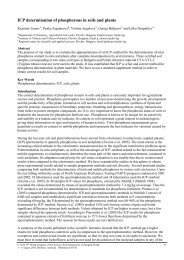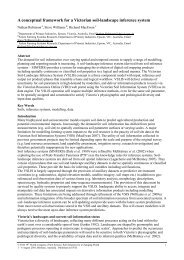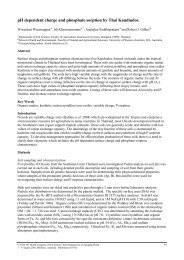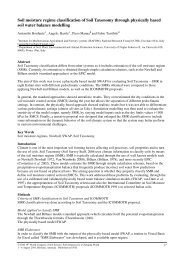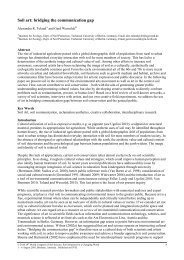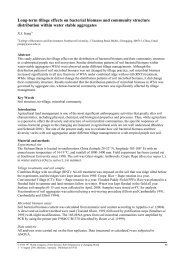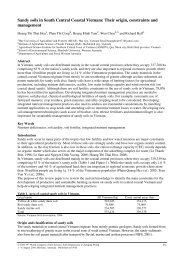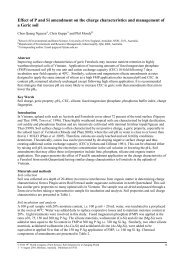Roychand Preeti
Roychand Preeti
Roychand Preeti
You also want an ePaper? Increase the reach of your titles
YUMPU automatically turns print PDFs into web optimized ePapers that Google loves.
Sorptive protection of organic matter in soil<br />
<strong>Preeti</strong> <strong>Roychand</strong> A , Michael Angove B and Judy Tisdall A<br />
A Faculty of Sci Eng and Tech, La Trobe University, Bundoora, 3086, Australia, Email p8sharma@student.latrobe.edu.au<br />
B Faculty of Sci, Eng and Tech, La Trobe University, Bendigo, 3550, Australia, Email M.Angove@latrobe.edu.au<br />
Abstract<br />
Soils are a significant sink for organic carbon, which can be protected from chemical and biological change,<br />
and hence conversion into greenhouse gases, such as CO 2 and CH 4 . In order to mitigate global climate<br />
change, and improve soil quality, the chemical mechanisms behind the long-term protection of organic<br />
matter must be understood, and strategies developed to improve this protection. Organic matter can be<br />
stabilised and protected in soil by a range of mechanisms, especially sorption. Sorption of organic matter to<br />
the surface of clay minerals via strong multiple complex bonds prevents hydrolytic enzymes approaching<br />
and decomposing the organic matter. We used clay minerals to study the sorption processes between organic<br />
matter and mineral phases, hence protection of the organic matter, that typically occur in soils. Initial results<br />
from sorption experiments show that humic acid was adsorbed more strongly to goethite than with kaolinite<br />
or montmorillonite. For all three mineral phases sorption was pH-dependent, with maximum sorption<br />
occurring at lower pH. XRD analysis in montmorillonite systems show that the sorbed humic acid decreased<br />
the‘d’ spacing of the 2:1 clay.<br />
Key Words<br />
Preservation, organic compounds, bonding.<br />
Introduction<br />
A huge volume of organic carbon comes from anthropogenic sources, for example, from waste disposal,<br />
such as effluents from wastewater treatment, or biosolids used as crop manure. Storage of this organic<br />
carbon in soil is desirable in order to prevent rapid conversion to greenhouse gases; the organic matter could<br />
also add valuable plant nutrients to the soil. The extent to which a soil can store and protect carbon depends<br />
on the a) physicochemical properties of the organic matter, b) the nature of the minerals in soil, and c) on soil<br />
properties, such as pH, salinity and presence of natural organic matter. Colloidal clays and minerals abound<br />
in soils, and, through various processes, including sorption, can act as an ecological barrier for<br />
immobilization and protection of organic carbon. The organic matter can be adsorbed onto mineral phases by<br />
several different mechanisms.<br />
Ion exchange<br />
Organic ions can be adsorbed via ion-exchange mechanisms. For example, the exchangeable cations on the<br />
surface of clay minerals may be replaced by organic cations. Cation exchange is involved in the sorption of<br />
various aminated benzenes by montmorillonite. Anionic organics may be adsorbed via interaction with<br />
amphoteric Al-OH groups of clays and soil minerals at low pH when these functional groups carry a net<br />
positive charge.<br />
Hydrogen bonding<br />
Hydrogen bonding can occur between surface hydroxyl groups and hydrogen or electronegative atoms of<br />
sorbing molecules. For example, polar functional groups on hydrophobic compounds can enhance sorption<br />
with inorganic surfaces through non-hydrophobic bonding, including hydrogen bonding (Boily et al. 2000).<br />
Pyridine forms strong hydrogen bonds with water molecules coordinated with interlayer cations in<br />
montmorillonite (Kubicki et al. 1999).<br />
Intercalation into the interlayer region of expanding clays<br />
Organic molecules may intercalate between the layers of expanding clays (Schnitzer 1987), and thereby help<br />
to increase sorption of non-ionic hydrophobic organic compounds (Spark et al. 1997). Such sorption of<br />
organic molecules by expanding clays such as montmorillonite, can involve interaction with external surface<br />
sites and/or the interlayer regions. For example, Schnitzer and Kodama (1966) proposed that the sorption of<br />
some pyridine derivatives involves sites on the external surfaces, as well as those between layers of<br />
montmorillonite (Schnitzer and Kodama 1966). Intercalation may involve several pathways, including a)<br />
© 2010 19 th World Congress of Soil Science, Soil Solutions for a Changing World<br />
1 – 6 August 2010, Brisbane, Australia. Published on DVD.<br />
235
cation exchange (Chen et al. 1987), b) dipole-dipole attractions, whereby organic molecules replace<br />
interlayer water molecules, or c) interaction with interlayer water molecules, via hydrogen bonding (Kubicki<br />
et al. 1999). When organic molecules penetrate the interlayers of expanding clays, the basal spacing of the<br />
clay is often increased (Chen et al .1987), decreased, or remains unchanged. X-ray Diffraction studies can<br />
provide information about the extent of the change in basal spacing, and thereby provide conclusive evidence<br />
for intercalation.<br />
Hydrophobic interactions<br />
Sorption of hydrophobic compounds can also occur through interaction with the more hydrophobic surfaces<br />
of mineral particles. The siloxane face of the clay mineral, for example, is more hydrophibic than are<br />
hydroxyl surfaces, and therefore the siloxane face interacts more readily with hydrophobic compounds. The<br />
sorption of hydrophobic compounds can depend on physicochemical properties, such as the hydrophobicity;<br />
a character that can be represented by the octanol-water partition coefficient (K ow value). For example,<br />
sorption of some neutral hydrophobic compounds is directly correlated with their K ow (Zhang et al. 1991)<br />
Methods<br />
The clay samples came from the Clay Minerals Society Source Clays Repository : a) Na-Montmorillonite<br />
(Wyoming) SWy-2 from Wyoming, USA, and b) Kaolin KGa-2 from Warren County, Georgia, USA. The<br />
surface areas (nitrogen adsorption) and cation exchange capacities (provided by the Clay Minerals Society)<br />
of these clay minerals were 31.8 m 2 /g and 76.4 cmol/ kg respectively for SWy-2, and 23.5 m 2 /g, and 2.0<br />
cmol/ kg respectively for KGa-2.<br />
Goethite was prepared by the modified method of Boily et al. (2000). Polycarbonate apparatus was used<br />
throughout to prevent silica contamination. To about 1.2 L of 1 M Fe(NO 3 ) 3 , (prepared from boiled milli-Q<br />
water), 5 M carbonate-free NaOH was added dropwise, under an atmosphere of N 2 , until the pH was 12.5.<br />
The dark brown precipitate was aged at 60 °C for 2 weeks. The suspension was then dialyzed against Milli-Q<br />
water under an atmosphere of N 2 , with the water changed twice daily until the conductivity was less than 1.0<br />
µS, after which the suspension was frozen before being freeze-dried.<br />
Humic acid was purified from the sodium salt by a method similar to that of Susic and Boto (1989). Sodium<br />
humate was mixed with Milli-Q water, and the pH adjusted to about 10 by the addition of 25% aqueous<br />
NH 4 OH. The mixture was centrifuged at 16 000 g for 10 min, and then concentrated HCl was added to<br />
precipitate the humic acid from the supernatant. The precipitate was collected by vacuum filtration<br />
(Whatman #1 filter paper), air-dried at 25 °C for 24 h, and oven-dried (80 °C) for 48 h.<br />
Humic acid used in the experiments was added from a 5.0 g/L stock solution, prepared by dissolution of<br />
purified humic acid standard in water. Dissolution was assisted by the addition of a few drops of NH 4 OH.<br />
Measurement of pH<br />
Great care was taken to ensure accurate measurement of pH in all experiments. Metrohm 691 pH meters with<br />
Orion Ross ‘Sure Flow’ and/or Metrohm combined pH-glass microelectrodes were used to measure pH.<br />
Before each experiment, the electrodes were calibrated at 25 ± 0.05 o C, with freshly-prepared NBS standard<br />
buffers at pH 4.01 and 6.86.The electrode calibration was checked at the end of each experiment to ensure<br />
that there had been no significant drift in the calibration during the experiment. Results were discarded if the<br />
re-calibration were outside 0.05 pH units. The pH electrodes were regularly checked and cleaned, according<br />
to manufacturer specifications.<br />
Humic acid determination<br />
Humic acid was determined by a method similar to that used by Susic and Boto (1989), by a Shimadzu<br />
HPLC system (SCL-10AVP) with fluorescence detection (RF-10AXL) at an excitation wavelength of 340<br />
nm and an emission wavelength of 455 nm. The mobile phase was about 0.003% ammonium hydroxide at<br />
pH 10, at a flow rate of 1.0 mL/min. A 150 x 4.6-mm I.D, 4 µm Synergy Fusion Reverse column<br />
(Phenomenex, Australia) (protected by a guard column with matching stationary phase material) was used<br />
for separation of humic acid. A six-point linear calibration curve (0-100 mg/L) with a correlation coefficient<br />
> 0.99 was used to calculate the humic acid concentrations in samples.<br />
© 2010 19 th World Congress of Soil Science, Soil Solutions for a Changing World<br />
1 – 6 August 2010, Brisbane, Australia. Published on DVD.<br />
236
Sorption experiments<br />
Suspensions that contained sufficient substrate to give a BET surface area of 100 m 2 /L were prepared by an<br />
appropriate mass of solid (0.4800 ± 0.0005 g goethite, 0.9400 ± 0.0005 g montmorillonite, or 1.2800 ±<br />
0.0005 g kaolinite) measured into 300 mL of 10 mM KNO 3 . Suspensions were stirred with a magnetic<br />
stirring bar (covered with Pyrex) and equilibrated for about 20 h in a jacketed, borosilicate glass reaction<br />
vessel (maintained at 25.0 ± 0.5 o C). The suspensions were continuously purged with humidified nitrogen to<br />
eliminate carbon dioxide. Sorption experiments were conducted in triplicate. At the start of each experiment,<br />
the pH of the suspension was adjusted to the required value by the addition of 0.1 M HNO 3 or KOH, and<br />
then humic acid, to the required concentration. The suspension was periodically sampled over 48 h, and the<br />
concentration of HA determined as described above. The pH was continuously monitored, and the<br />
suspension continuously purged with nitrogen gas.<br />
Results<br />
Sorption experiments<br />
The sorption of humic acid to goethite, kaolinite and montmorillonite is pH-dependent, with maximum<br />
sorption at low pH (Figure 1). This behaviour is typical for the sorption of humic and fulvic substances by<br />
mineral phases. At low pH, mineral surfaces may carry a positive charge, which can interact with a) ionized<br />
negatively-charged groups of dissolved organic matter, or b) by hydrogen bonding with –C=O from<br />
carboxylic acids. The sorption of humic acid on goethite was the highest of the three substrates. This is not<br />
surprising because the goethite surface is known to have a higher surface charge density than do<br />
phyllosilicate minerals. The point of zero charge (PZC) for the goethite sample used in this study was about<br />
8.5, so the surface had a net positive charge below this pH. The lower sorption of the dissolved organic<br />
material observed for the clay minerals is probably because of the lower concentration of positive charged<br />
sites on their surfaces. Lower sorption of organic anions onto clays has often been observed. For example,<br />
various benzene carboxylates (simple analogues of complex humic and fulvic structures) were adsorbed<br />
significantly less to kaolinite than to goethite (Spark et al. 1997) The decrease in sorption at higher pH<br />
results from repulsion between the increasingly negative surface charge, and the negatively charged<br />
carboxylate groups on the humic acid.<br />
The XRD data for the sorption of humic acid to montmorillonite (Figure 2) shows that the basal spacing of<br />
the montmorillonite decreases significantly when humic acid is present. Changes in basal spacing for<br />
swelling clays have often been used as diagnostic evidence for intercalation of solutes. However, the change<br />
in basal spacing observed with added humic acid is in the opposite direction to that expected for the<br />
intercalation of such bulky molecules. Furthermore, sorption of humic acid to montmorillonite was fully<br />
reversible, which was unexpected with the large molecules that intercalated into the clay structure. This<br />
suggests that the humic acid did not intercalate, but was rather adsorbed to the external surfaces of the<br />
montmorillonite.<br />
100<br />
80<br />
% Sorbed<br />
60<br />
40<br />
20<br />
0<br />
3 4 5 6 7 8 9 10<br />
pH<br />
Figure 1. Sorption of humic acid at 25 o C to 100 m 2 /L to goethite (○), kaolinite (□) and montmorillonite (∆).<br />
Initial concentration of the humic acid was 50 mg/ L.<br />
Background electrolyte 10 mM KNO 3 .<br />
© 2010 19 th World Congress of Soil Science, Soil Solutions for a Changing World<br />
1 – 6 August 2010, Brisbane, Australia. Published on DVD.<br />
237
Error! Objects cannot be created from editing field codes.<br />
Figure 2. X-ray diffractograms of dried samples of montmorillonite suspensions at pH 4.5: (a) without<br />
humic acid, (b) with added humic acid; and pH 10.5: (c) without humic acid, and (d) with added humic<br />
acid.<br />
Conclusion<br />
Sorption is pH-dependent, with more humic acid adsorbing to the iron oxide compared with the clay<br />
minerals, probably because of the higher surface charge density on goethite compared with the clays. The<br />
sorption of humic acid to montmorillonite decreased the ‘d’ spacing, perhaps suggesting that intercalation<br />
was not the primary mechanism for uptake of humic acid on that clay. This may be significant, because<br />
surface-bound organic matter is generally thought to be more prone to degradation than is that which diffuses<br />
into micro porous clay structures.<br />
References<br />
Beckett R (1990) Surface and Colloid Chemistry in Natural Waters and Water Treatment. (Plenum: New<br />
York).<br />
Boily JF, Persson P, Sjöberg S (2000) Benzene carboxylate surface complexation at the goethite/water<br />
interface Geochim. Cosmochim. Acta 64, 3453–3470.<br />
Chen S, Low PF, Cushman JH, Roth CB (1987) Organic compound effects on swelling and flocculation of<br />
Upton montmorillonite Soil Science Society of America Journal 51, 1444-1450.<br />
Kubicki JD, Schroeter LM, Itoh, MJ, Nguyen BN, Apitz SE (1999). Attenuated total reflectance Fouriertransform<br />
infrared spectroscopy of carboxylic acids adsorbed into mineral surfaces. Geochim.<br />
Cosmochim. Acta 63, 2709–2725.<br />
Schnitzer M (1986) Binding of humic substances by soil mineral colloids. In ‘Interactions of Soil Minerals<br />
with Natural Organics and Microbes’. pp. 77-102.<br />
Scnitzer M, Kodama H (1966) Montmorillonite: Effect of pH on its adsorption of a soil humic compound.<br />
Science 15, 70-71.<br />
Spark KM, Wells JD, Johnson BB (1997) Characteristics of the sorption of humic acid by soil minerals<br />
Australian Journal of Soil Research 35, 103-112.<br />
Susic M, Boto KG (1989) Performance liquid chromatographic determination of humic acid in<br />
environmental samples. Journal of Chromatography 482, 175-187.<br />
Zhang Y, Gan H, Low PF (1991) Effect of sodium-humate on the rheological characteristics of<br />
montmorillonite suspensions Soil Science Society of America Journal 55, 989-993.<br />
© 2010 19 th World Congress of Soil Science, Soil Solutions for a Changing World<br />
1 – 6 August 2010, Brisbane, Australia. Published on DVD.<br />
238



